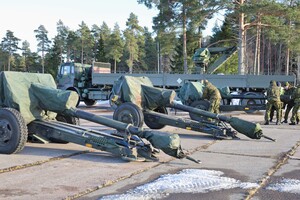The Russian war forces Kyiv to make the fastest-ever transition to NATO standards, making its membership in the alliance inevitable.

Defending the country is such a difficult task. And it is even harder to defend oneself and at the same time move from heavy Russian-made weapons to a new and unfamiliar arsenal of Western howitzers, armored vehicles and ammunition by NATO standards. To survive, you need to change everything from training to supply chains. And all this in the midst of battle.
This is exactly the task facing Ukraine. And no one has done anything like that, – writes Forbes. The logistical challenge is huge. Western ammunition or other military consumables are not related to heavy weapons made in Russia. So when the transition to Western missiles, grenades, artillery and tank shells, and medium-caliber weapons begins, Ukrainian soldiers will not be able to simply grab a box of Western ammunition from a truck and use it to fire their old guns. Calibers are completely different. But the flow of logistics for both old and new weapons must be maintained so that the right things can quickly get to the right points on the battlefield.
Read also: Ukraine needs weapons not just as soon as possible, but now – Zelensky
But the situation is actually even more complicated. The more complex a military platform, the harder it is to move on. Western tanks run on a completely different fuel. Their service cycles are also different. Even tools in garages are needed to repair them. Therefore, such rearmament is difficult even in peacetime. Now the Ukrainian army is coping with “old” Russian ammunition and platforms. In order to keep the resistance going, the countries that were once part of the Warsaw Pact are handing over to the Armed Forces old stockpiles of Soviet ammunition, weapons and other equipment that is still in working order. Everything that can be used with the weapons available in Ukraine is taken from dusty warehouses and sent to the front. But this antique is often stored in questionable conditions. And its reserves are exhaustible.
In Ukraine, ammunition and other consumables are running out. And the West's ability to support equipment of Russian origin is very limited. Not many manufacturers in Eastern Europe can still produce ammunition and spare parts. New sources of supply are also unlikely to be found. The war made the production of obsolete ammunition and spare parts for Russian equipment profitable. However, it simply does not make sense to increase such production capacity. Because as soon as the T-64, T-72 and T-80 tanks run out in Ukraine, Western demand for Russian ammunition will also disappear.
In Ukraine, there is no choice but to start the transition to Western weapons. At some point, there will simply be no old Soviet arsenals left in the West. Therefore, Ukraine must learn to use Western defense systems in the midst of a desperate battle. Over the past decade, NATO has sought to understand how countries such as the Czech Republic, Hungary, Poland and Bulgaria are gradually switching to Western weapons. Now these studies have become relevant again.
NATO has realized that a lot of work needs to be done to adapt the new members in order to resolve differences in military ammunition. The new member states had to replace or upgrade almost ninety different weapons systems. The Ukrainian Army effectively uses Stinger and Javelin missiles. However, due to this success, the society may not realize what a great challenge the Armed Forces will face in the near future. The publication notes that all these missiles are disposable. So it was necessary to conduct simple training. And the infrastructure for service and support in the case of such weapons is not particularly needed. That's why the Armed Forces were able to hit Stinger and Javelin missiles so quickly on the Russian army, which did not have time to change tactics. Admittedly, Ukraine was able to surprisingly quickly switch to these types of Western weapons. However, it will be more difficult.
Even the transfer of basic weapons for infantry to Ukraine will not go smoothly. For example, if Russian submachine guns can be cleaned with sparkling water and a rag, switching to a modern rifle or NATO machine gun will mean that soldiers will have to learn different firing protocols and learn new methods of service. And all this in the process of establishing new supply chains for ammunition and spare parts.
Read also: Germany will violate its “security philosophy” and continue to provide Ukraine with weapons – Steinmeier
The current challenge for donor countries is to make the most of the time before old Ukrainian systems break down or run out of ammunition. For example, the Armed Forces effectively use artillery on the battlefield. To maintain this effectiveness, Ukrainian soldiers need to switch to 155-millimeter guns used in NATO countries, as well as master advanced guidance systems. Such things are not done in a day. However, the first steps have already been taken. The White House has announced the transfer of 18 basic artillery units with a caliber of 155 millimeters, as well as 40 thousand shells for them. Ukraine also received AN/TPQ-36 anti-battery radars. This can be considered the beginning of the renewal of Ukrainian artillery and guidance infrastructure. Training will begin in a few days. But the real challenge will be to scale up these new capabilities so that new guns appear on the front line quickly and in sufficient numbers to change the course of events.
In mechanized combat, the gradual introduction of new capabilities is not effective. During World War II, new tanks, fighters and other equipment did not go into battle en masse. Therefore, their effectiveness was insignificant. Ukraine may face a similar problem. Ukrainian needs on the battlefield are very acute. However, the new heavy weapons that Kyiv is receiving are much more effective if it is brought into battle en masse and with strong support to fully unleash its potential. Given the public announcement that NATO's first battery of 155mm guns is arriving in Ukraine, other Western arsenals should already be deconserving their old artillery systems and quietly preparing as many howitzers as possible for the Armed Forces in the coming months. Russia must face a completely new Ukrainian artillery with new capabilities and devastating tactics.
In addition to Western howitzers, we need to think about what other high-tech tools Ukraine will need. And then start preparing the ground for their implementation now. Something like this is slowly happening. 200 M113 armored personnel carriers are included in the current assistance package. And this is the first step of Ukraine towards the transition to NATO tanks and other armored vehicles.
If you put aside all the difficult furnishings, the current events look quite ironic. While Russia is at war to prevent Ukraine from joining NATO, the Ukrainian army is preparing to make the fastest transition to NATO's arsenal of standards in modern history. Because of the war, Ukraine is becoming a de facto NATO country, whether Vladimir Putin likes it or not. Continuing this war, the Kremlin makes Ukraine's accession to NATO inevitable.
Earlier, Ukrainian President Volodymyr Zelensky said in a speech at the NATO summit that > Ukraine needs military aid without restrictions, as the Ukrainian army has been resisting the Russian occupiers in unequal conditions for a month.
In turn, NATO Secretary General Jens Stoltenberg promised that the alliance would provide Ukraine with “as many weapons as needed”.
See the special topic: The Russian Army planned a military invasion of Belarus – GUR The plan was developed after the falsification of the presidential election in Belarus. Ukraine will be rebuilt by polytechnic universities: what needs to be done Heads and money – factors in the revival of Ukraine « Enemy equipment is on fire, native Ukraine will win “- Ukrainian stars recorded a song about winning the war Oleksandr Ponomaryov, Yuriy Tkach, Taras Topolya and others took part in recording the song. Ukrainian defenders shot down Russian Orlan-10 UAV over Odessa The drone was trying to reconnoiter Odessa's critical infrastructure. Fraudsters use Facebook to obtain Ukrainian bank card details The attackers offer to receive financial assistance from the EU.


